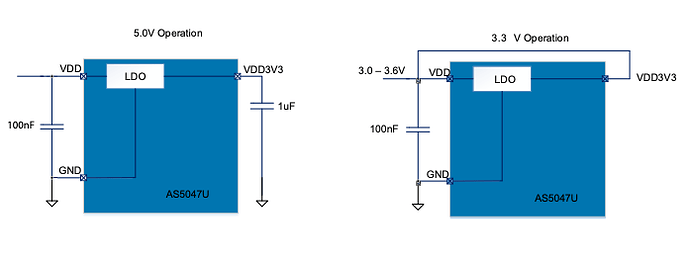Hi Guys,
I am trying to use the AS5047U magnetic encoder in incremental mode with a CubeMars GL40 motor and an Odrive 3.6 to do FOC control. I know the encoder spreadsheet indicates that these are not supported, but surely that refers to non-incremental data acquisition modes? I can’t see why this chip’s incremental interface would be different from others, but I am a novice with electronics.
The encoder is mounted on the rear of the motor. The magnet is as close to the chip centre as possible with a Z spacing of ~0.5mm. Here are some screengrabs to get an idea of the setup.
Right now, the encoder is giving no response at all in incremental mode or SPI mode. I have attached probes from an oscilloscope to the appropriate pins to inspect both of these modes of operation. 0V with respect to GND is reported on the A/B/I lines with rotation of the motor. This remains true when I try to wave a magnet across the encoder to induce any noise signal.
I have also tried communicating with the device over SPI, using an Arduino as a master. I have attached probes to the SPI lines as well, and they report no signal on the MISO line. The code for communicating with the SPI bus is below.
#include <SPI.h>
const int cs = 10;
const int clk = 13;
const int mosi = 11;
const int miso = 12;
#define DATA_MASK 0x3FFF
#define OP_WRITE 0x0000
#define OP_READ 0x4000
#define PARITY_EVEN 0x0000
#define PARITY_ODD 0x8000
#define ADDR_NOP 0x0000
#define ADDR_ERRFL 0x0001
#define ADDR_PROG 0x0003
#define ADDR_DIAAGC 0x3FFC
#define ADDR_MAG 0x3FFD
#define ADDR_ANGLEUNC 0x3FFE
#define ADDR_ANGLECOM 0x3FFF
#define ADDR_SETTINGS1 0x0018
#define ADDR_SETTINGS2 0x0019
#define CMD_R_NOP (OP_READ | ADDR_NOP)
#define CMD_R_ERRFL (OP_READ | ADDR_ERRFL)
#define CMD_R_PROG (OP_READ | ADDR_PROG)
#define CMD_R_DIAAGC (OP_READ | ADDR_DIAAGC)
#define CMD_R_MAG (OP_READ | ADDR_MAG)
#define CMD_R_ANGLEUNC (OP_READ | ADDR_ANGLEUNC)
#define CMD_R_ANGLECOM (OP_READ | ADDR_ANGLECOM)
#define CMD_R_SETTINGS1 (OP_READ | ADDR_SETTINGS1)
#define CMD_R_SETTINGS2 (OP_READ | ADDR_SETTINGS2)
int16_t AS5047_Read(int ic_cs, uint16_t command){
int16_t res = 0;
// First frame of SPI - send a 16 bit command
digitalWrite(ic_cs, LOW);
SPI.transfer16(command);
digitalWrite(ic_cs, HIGH);
// Second frame of SPI - read the result of the command
digitalWrite(ic_cs, LOW);
res = SPI.transfer16(CMD_R_NOP);
digitalWrite(ic_cs, HIGH);
// Mask off unused bits
res &= DATA_MASK;
return res;
}
void setup() {
// put your setup code here, to run once:
Serial.begin(9600);
pinMode(cs,OUTPUT);
SPI.beginTransaction(SPISettings(
100000, MSBFIRST,
SPI_MODE1)); // Configure SPI for this transaction and begin transaction
}
void loop() {
// put your main code here, to run repeatedly:
int16_t masked_data = AS5047_Read(cs, CMD_R_SETTINGS1);
Serial.println(masked_data);
delay(10);
}
I have included my schematic below as a reference in case I have done something completely wrong. I have included some notes about the modifications and debugging I attempted.
Any help would be greatly appreciated.




